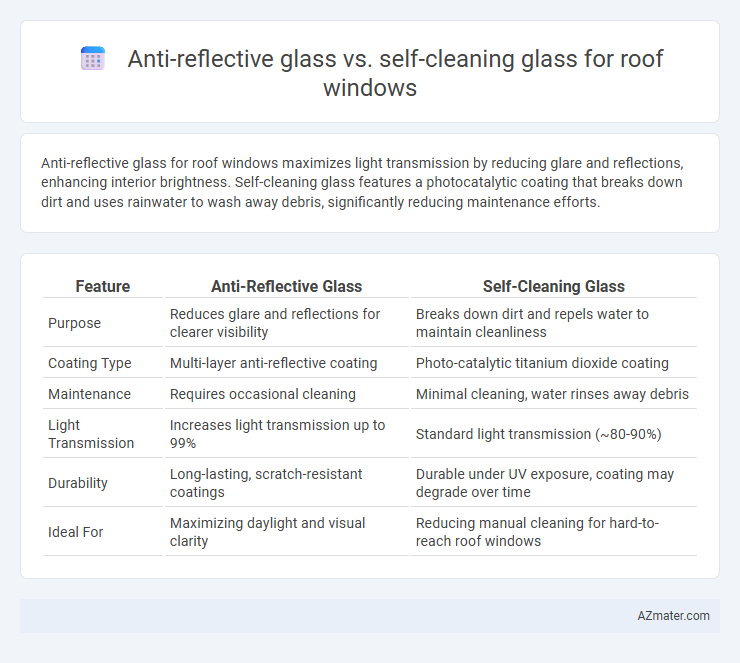Anti-reflective glass for roof windows maximizes light transmission by reducing glare and reflections, enhancing interior brightness. Self-cleaning glass features a photocatalytic coating that breaks down dirt and uses rainwater to wash away debris, significantly reducing maintenance efforts.
Table of Comparison
| Feature | Anti-Reflective Glass | Self-Cleaning Glass |
|---|---|---|
| Purpose | Reduces glare and reflections for clearer visibility | Breaks down dirt and repels water to maintain cleanliness |
| Coating Type | Multi-layer anti-reflective coating | Photo-catalytic titanium dioxide coating |
| Maintenance | Requires occasional cleaning | Minimal cleaning, water rinses away debris |
| Light Transmission | Increases light transmission up to 99% | Standard light transmission (~80-90%) |
| Durability | Long-lasting, scratch-resistant coatings | Durable under UV exposure, coating may degrade over time |
| Ideal For | Maximizing daylight and visual clarity | Reducing manual cleaning for hard-to-reach roof windows |
Introduction to Roof Window Glass Technologies
Roof window glass technologies enhance natural light and durability through specific coatings and treatments designed for varying functional benefits. Anti-reflective glass maximizes light transmission by minimizing glare and reflections, ensuring clearer views and improved energy efficiency. Self-cleaning glass incorporates photocatalytic and hydrophilic coatings that break down organic dirt and allow rainwater to wash it away, reducing maintenance for roof windows exposed to the elements.
What is Anti-Reflective Glass?
Anti-reflective glass for roof windows features a special coating that reduces glare and improves light transmission, enhancing indoor brightness without compromising energy efficiency. This glass minimizes reflections from sunlight, allowing more natural light to enter while maintaining clear visibility through the window. By maximizing transparency and reducing glare, anti-reflective glass optimizes daylight usage and contributes to a comfortable, visually appealing indoor environment.
What is Self-Cleaning Glass?
Self-cleaning glass for roof windows utilizes a special photocatalytic coating that breaks down organic dirt when exposed to sunlight, allowing rainwater to wash away residue more easily. This technology reduces maintenance and keeps the glass clearer without manual cleaning. Compared to anti-reflective glass, which minimizes glare and improves light transmission, self-cleaning glass prioritizes durability and cleanliness for optimal performance in exterior applications.
Key Differences: Anti-Reflective vs Self-Cleaning Glass
Anti-reflective glass for roof windows reduces glare and enhances light transmission by minimizing surface reflections, improving interior brightness and clarity. Self-cleaning glass utilizes a photocatalytic coating that breaks down organic dirt when exposed to sunlight and a hydrophilic surface that allows water to spread evenly for easier cleaning. The key difference lies in functionality: anti-reflective glass focuses on optical performance, while self-cleaning glass prioritizes maintenance and surface cleanliness.
Optical Clarity and Light Transmission Comparison
Anti-reflective glass for roof windows offers superior optical clarity by minimizing surface reflections, allowing up to 98% of natural light to transmit through the pane, enhancing interior brightness without glare. Self-cleaning glass features a photocatalytic coating that breaks down organic dirt and a hydrophilic surface that washes residues away with rain, but its light transmission typically ranges between 85-90% due to the additional coatings reducing clarity. Choosing anti-reflective glass prioritizes maximum light transmission and crisp views, while self-cleaning glass balances maintenance ease with slightly reduced optical performance.
Maintenance and Cleaning Frequency
Anti-reflective glass for roof windows reduces glare and improves visibility, requiring regular cleaning to maintain its clarity and performance, typically every 3 to 6 months depending on environmental exposure. Self-cleaning glass features a special coating that breaks down organic dirt and allows rainwater to wash away debris, significantly reducing cleaning frequency to once or twice a year. Both types enhance roof window durability, but self-cleaning glass offers superior low-maintenance benefits for hard-to-reach installations.
Durability and Longevity Aspects
Anti-reflective glass for roof windows offers enhanced durability with coatings that resist scratches and weathering, maintaining clarity over time. Self-cleaning glass combines a photocatalytic and hydrophilic coating that breaks down organic dirt and allows rainwater to wash away residues, but its longevity depends on environmental factors such as UV exposure and pollution levels. In terms of lifespan, anti-reflective glass generally retains its optical properties longer under harsh conditions, while self-cleaning coatings may require periodic reapplication to sustain their effectiveness.
Energy Efficiency and Thermal Performance
Anti-reflective glass for roof windows enhances energy efficiency by maximizing natural light transmission, reducing the need for artificial lighting, and improving solar heat gain control to maintain thermal comfort. Self-cleaning glass, coated with photocatalytic and hydrophilic layers, primarily reduces maintenance efforts but also contributes to thermal performance by preventing dirt accumulation that can decrease light penetration and insulation effectiveness. Choosing between the two depends on prioritizing consistent light optimization and solar heat management with anti-reflective glass or balancing low maintenance with sustained thermal efficiency via self-cleaning coatings.
Cost Considerations for Roof Windows
Anti-reflective glass for roof windows generally comes at a higher initial cost due to advanced coatings designed to reduce glare and improve light transmission. Self-cleaning glass involves a specialized catalytic and hydrophilic coating that can increase upfront expenses but may reduce long-term maintenance costs by minimizing the need for manual cleaning. When considering cost for roof windows, balancing the higher initial investment of self-cleaning glass against potential savings in cleaning and maintenance is crucial, while anti-reflective glass offers value through enhanced daylighting and energy efficiency benefits.
Which Glass Type is Best for Your Roof Window?
Choosing between anti-reflective glass and self-cleaning glass for your roof window depends on your priorities: anti-reflective glass significantly reduces glare and enhances natural light penetration, ideal for optimizing indoor brightness and visual comfort. Self-cleaning glass features a special coating that breaks down dirt and allows rainwater to wash it away, reducing maintenance and keeping the window clearer over time. For homes in sunny areas where maximizing light and reducing reflections is crucial, anti-reflective glass is best; in contrast, self-cleaning glass suits locations prone to dust and pollution, minimizing cleaning efforts.

Infographic: Anti-reflective glass vs Self-cleaning glass for Roof window
 azmater.com
azmater.com